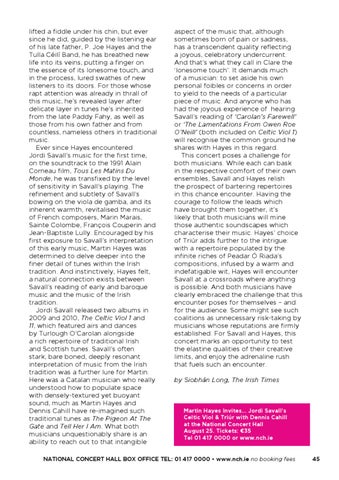lifted a fiddle under his chin, but ever since he did, guided by the listening ear of his late father, P. Joe Hayes and the Tulla Céilí Band, he has breathed new life into its veins, putting a finger on the essence of its lonesome touch, and in the process, lured swathes of new listeners to its doors. For those whose rapt attention was already in thrall of this music, he’s revealed layer after delicate layer in tunes he’s inherited from the late Paddy Fahy, as well as those from his own father and from countless, nameless others in traditional music. Ever since Hayes encountered Jordi Savall’s music for the first time, on the soundtrack to the 1991 Alain Corneau film, Tous Les Matins Du Monde, he was transfixed by the level of sensitivity in Savall’s playing. The refinement and subtlety of Savall’s bowing on the viola de gamba, and its inherent warmth, revitalised the music of French composers, Marin Marais, Sainte Colombe, François Couperin and Jean-Baptiste Lully. Encouraged by his first exposure to Savall’s interpretation of this early music, Martin Hayes was determined to delve deeper into the finer detail of tunes within the Irish tradition. And instinctively, Hayes felt, a natural connection exists between Savall’s reading of early and baroque music and the music of the Irish tradition. Jordi Savall released two albums in 2009 and 2010, The Celtic Viol 1 and 11, which featured airs and dances by Turlough O’Carolan alongside a rich repertoire of traditional Irish and Scottish tunes. Savall’s often stark, bare boned, deeply resonant interpretation of music from the Irish tradition was a further lure for Martin. Here was a Catalan musician who really understood how to populate space with densely-textured yet buoyant sound, much as Martin Hayes and Dennis Cahill have re-imagined such traditional tunes as The Pigeon At The Gate and Tell Her I Am. What both musicians unquestionably share is an ability to reach out to that intangible
aspect of the music that, although sometimes born of pain or sadness, has a transcendent quality reflecting a joyous, celebratory undercurrent. And that’s what they call in Clare the ‘lonesome touch’. It demands much of a musician: to set aside his own personal foibles or concerns in order to yield to the needs of a particular piece of music. And anyone who has had the joyous experience of hearing Savall’s reading of ‘Carolan’s Farewell’ or ‘The Lamentations From Owen Roe O’Neill’ (both included on Celtic Viol 1) will recognise the common ground he shares with Hayes in this regard. This concert poses a challenge for both musicians. While each can bask in the respective comfort of their own ensembles, Savall and Hayes relish the prospect of bartering repertoires in this chance encounter. Having the courage to follow the leads which have brought them together, it’s likely that both musicians will mine those authentic soundscapes which characterise their music. Hayes’ choice of Triúr adds further to the intrigue: with a repertoire populated by the infinite riches of Peadar Ó Riada’s compositions, infused by a warm and indefatigable wit, Hayes will encounter Savall at a crossroads where anything is possible. And both musicians have clearly embraced the challenge that this encounter poses for themselves – and for the audience. Some might see such coalitions as unnecessary risk-taking by musicians whose reputations are firmly established. For Savall and Hayes, this concert marks an opportunity to test the elastine qualities of their creative limits, and enjoy the adrenaline rush that fuels such an encounter. by Siobhán Long, The Irish Times
Martin Hayes Invites... Jordi Savall’s Celtic Viol & Triúr with Dennis Cahill at the National Concert Hall August 25. Tickets: ¤35 Tel 01 417 0000 or www.nch.ie
NATIONAL CONCERT HALL BOX OFFICE TEL: 01 417 0000 • www.nch.ie no booking fees
45
